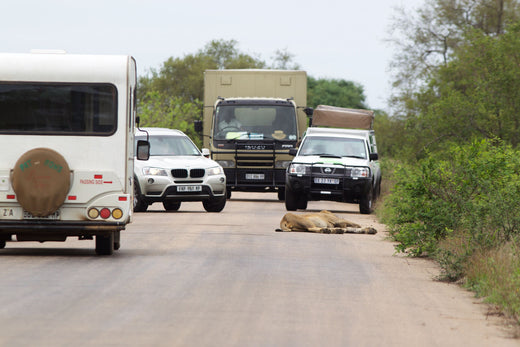
Five Top Tarred Roads in Kruger National Park
Share
‘Tarred roads? In a National Park? You may think this is crazy. Shouldn’t a renowned game reserve be ‘wild’ and as true to nature as possible? Stevenson-Hamilton also thought so. He vehemently opposed the building of tarred roads in the Park until his retirement. He was seriously concerned that tarred roads would lead to speeding and that this in turn would lead to carnage of wildlife ‘beyond all bounds’.
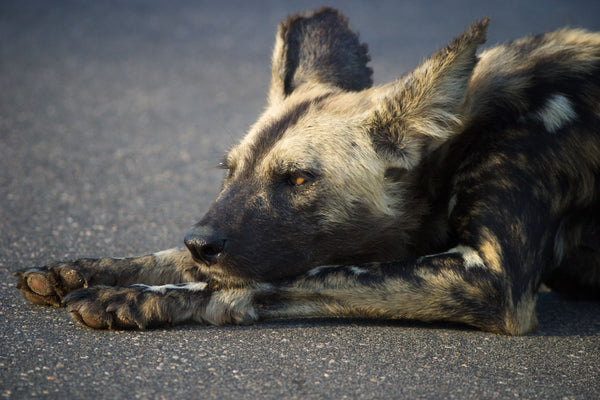
In a way he was right. Regular visitors to the Park are indeed concerned about speeding – mostly by insensitive drivers of service vehicles providing the necessary supplies to support the infra structure of the Park. There are indeed also impatient speeding visitors who expect game to pose for them instead of them spotting the game themselves by driving slowly.
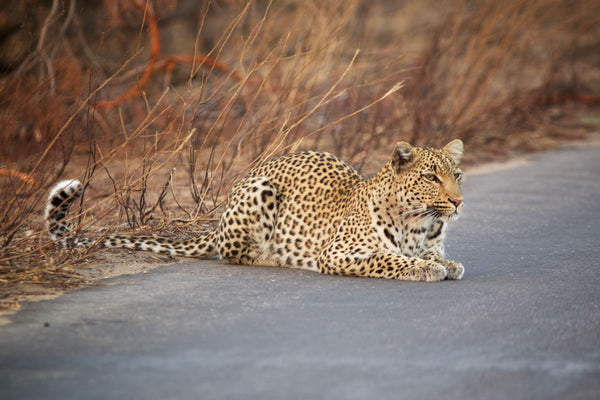
Today the tarred roads of the Kruger National Park are an iconic presence. On asking an American what she would regard as a representative image of Kruger, she immediately replied ‘lions on a tarred road’. And yes, of course, I thought, where else in the World would one see lions lounging on tar? But do tarred roads distract from the wilderness feeling? Most people say no, they like their comforts even in the bush. No dust, open windows, no teeth-clattering corrugations and all-in-all a smooth comfortable drive despite adverse weather conditions. The dirt-roaders say ‘please may the majority keep to their comforts, we prefer solitude and silence despite corrugations and dust’.
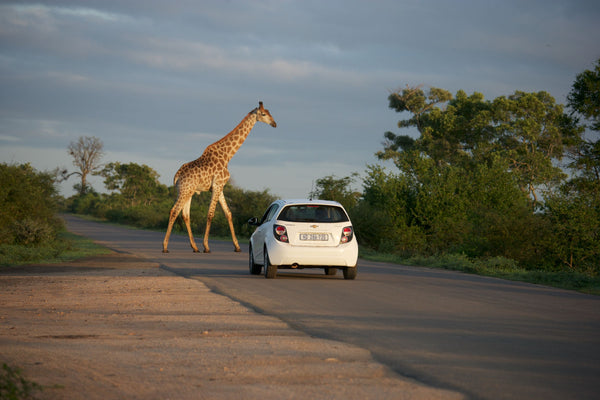
The dust was one of the reasons for building tarred roads. The argument is that the build-up of dust on plants next to busy game viewing dirt roads is not aesthetically pleasing and may be detrimental for game. Anybody who has driven the S100 an hour before gate closing time during winter months can tell what heavy traffic does to visibility on a dirt road. Another disappointment is that favourite roads may be closed for game drives after heavy rains to protect the road surface and the tourists from getting stuck.
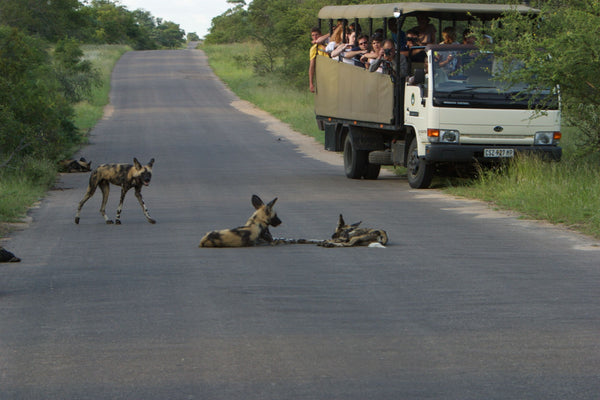
Eco-friendly tarring of the first Kruger road commenced in August 1965. Today there are more than 850 kilometers of tarred roads in the Park. The remaining 1 444 kilometers of dirt roads will probably not be tarred soon (if ever) and will remain preferred backroads for those who value an intimate bush experiences. For the tarred roads in the Park, bitumen is used rather than tar. It looks the same as tar but bitumen is a residue created when oil is refined and is relatively inert. Tar is made from coal and contains cancer-causing hydrocarbon compounds which can leach into the soil water.

The down side of eco-friendly tarred roads is that they require regular resealing. They contain no crushed stone but are sand-sealed and created from hot bitumen and sand. This involves stockpiling sieved and silt free river sand in places where the upgrading has to be done. Hot bitumen is then shipped into the Park with several tankers to ensure an uninterrupted supply for a couple of kilometers at a time. A coat of hot bitumen is sprayed onto the old road surface and then immediately covered by a layer of sand from a sand spreader. A roller follows to compact the surface and to give a smooth finish. The good news is that as soon as the rolling is done, the road is ready to be driven on and that as the road degrades over the years, the sand is eventually washed back into the rivers.
The most popular tarred road in the in southern section of the Park is arguably the road between Skukuza and Crocodile Bridge via Lower Sabie (i.e. H4-1 and H4-2). The main attraction is that the road hugs the perennial Sabie River for most of the way, is extremely scenic and offers ideal habitat for most kinds of predator and other game. The probability of good sightings and witnessing action is high. The downside is that everyone knows this, and traffic congestion does occur around good sightings. Courtesy and lots of patience is the name of the game.
The other popular tarred road is the stretch between Skukuza and Satara (i.e. H1-2 and H1-3). This is an excellent drive that offers a diversity of landscapes and the possibility to see most of the general game found in the Park. The section where the road runs along the Sand River is good, also the area around the Mantimahle Dam and Olifantsdrinkgat where the grass is sweet and attracts a lot of game. One should be vigilant from the huge boulders with the Kruger Tablets up to Leeupan.

After Tshokwane picnic site visibility is excellent and the road passes reliable water sources and game is plentiful. The reason for the abundance of game in this area lies in the geology, soil and vegetation of the surrounding plains. The grasses are sweet and the landscape is mostly parklike and open with knob-thorn and marula as the dominant tree species. The soils tend to retain water well into the dry season and therefore game gathers on these plains for nutritious grazing. The seasonal N’waswitsontso and Sweni watercourses have semi-permanent pools even into the dry season while the Kumana Dam and the Mazithi Pan are two reliable watering places on the H1-3.
The H10 between Lower Sabie and Tshokwane picnic site is yet another of the fine game-viewing roads in the Park. Visibility is good, game densities are high and the possibility of sighting all of the Big Five in one game drive is high. Elephants favour the lush vegetation in the drainage lines where fever trees (light green), sycamore figs (yellowish stems), leadwoods (tall and upright) and jackal-berries (huge, dark green rounded canopies, yellowish in early spring) line the streambed. A special sighting on this road would be reedbuck that keep in the vlei areas of the Mlondozi drainage line. Another would be the klipspringer on the rocky ridges of the Nkumbe Hill. Framed by the scarce Lebombo euphorbias (Euphorbia confinalis), the Nkumbe Lookout offers one of the grandest vistas of the seemingly endless bushveld.
Imagine the chaos that would have ensued if these five maginificent drives would have been gravelled roads. With more than about 4500 visitors in the park each day much of the grandeur of Kruger would have been lost in dust and frustration.



5 comments
In light of recent slaughter scenes of animals being struck by speeding vehicles (mainly taxis and staff busses), it is clear that any wildlife enthuasiast will stick to dirt roads rather than risking death. The latest scene is that of a taxi speeding into a giraffe that ambled onto the road. The giraffe was knocked over onto a tourist’s vehicle and ultimately ended killing the Swiss tourist. Having had only gravel roads would deter taxis from using the KNP as a by-pass to the dilapidated roads that they should in fact be using outside the park. Also, ironically and sadly, a staff bus was also involved in a slaughter when it sped past a visitor and into a group of Impala. There is no prosecution on speeding vehicles (especially taxis), it’s like the Wild West but African version.
With the volume of traffic in the KNP it is wise and prudent to have “hard-top” on the most popular routes. Certainly the tar has not diminished the game viewing opportunities, and when we really want to “get away from it all” – a back less traveled route is always an option..
I have visited KP about 54 times since 1949, and was one of those who really resisted the tarring of the roads, but the park is now hardly a wilderness experience, and some of my most memorable sightings have been on or right next to the tar……wild dog kill, lion kills, many leopards walking along marking their territories, zebra stallions fighting – and so on. (Still hate a photograph showing tar though ….🙁).
Beautiful, it’s always great;
" With more than about 4500 visitors in the park each day much of the grandeur of Kruger would have been lost in dust and frustration."
Certainly many more during school holidays and week ends. It is the number of visitors which is too high, but with less visitors, less money and that is the weakness of Sanparks.
Less conservation and more money, that is the Sanparks’ policy these days!!